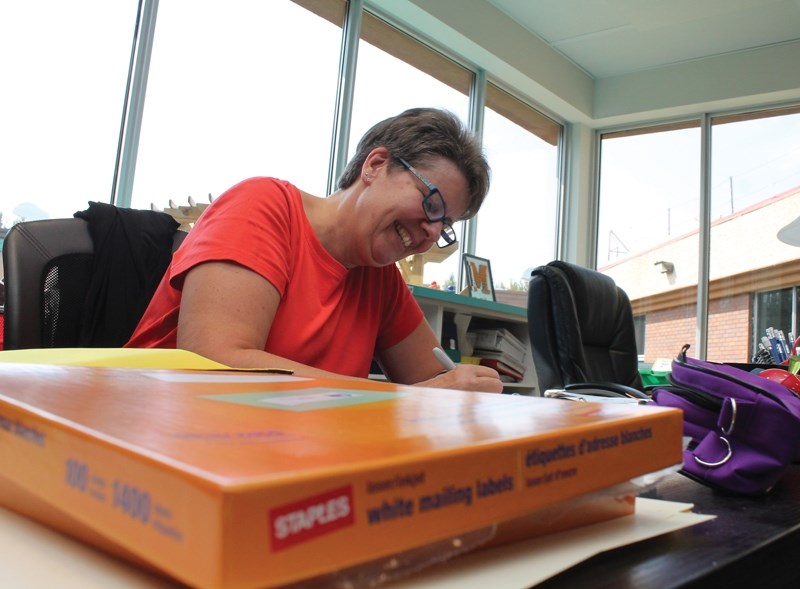In the lead up to the start of the school, which was yesterday, Aug. 31 for Pembina Hills students and today, Sept. 1 for St. Mary School kids, the Westlock News took at look at some of the new things set for schools in the town.
For Part 2 we leave the town boundary behind to take a peek at what’s in store for students at our rural schools in Clyde, Busby and Dapp.
This school year sees Clyde’s K-9 school joining the Chromebook program.
All kids in Grades 5 to 9 will have a laptop computer, which will be integrated into their classroom work and self guided learning.
“Students will have their own Chromebook at school that they can log into when asked to by teachers for research projects pretty much right away. So where pretty excited about that,” said principal Don Hinks.
He believes that having access to, and using, the computers will add another way of learning and teaching.
“We’re trying to give students a different way to express themselves, not all students learn the same way and this provides them with another medium to do presentations and research and to do things through technology,” he said.
“We all know that for students in this day and age technology is the definitely the way to go for the 21st century learner.”
Chromebooks are computers developed by web-search-giant Google. They are often more cost effective than machines running Windows or Apple operating systems because a lot of the computing power is handled on external Google servers.
While the computers were taking a greater role in student learning, Hinks pointed out that they weren’t a substitute for traditional teaching methods.
“It’s certainly doesn’t replace quality teaching,” he said. “It’s there to enhance quality teaching.”
In the north of the county, capital works are the focus for the start of the school year.
The Pembina North Community School is currently in Stage 2 of a significant three-part upgrade to its facilities.
Completed over summer was work to the library and staff areas, while renovations are currently underway in parts of the lower elementary learning areas. Stage 3 will see improvements made to the junior high section of the school.
Principal Darcie Eamor was positive about the building improvements, despite the potential for disruption.
“This is a very exciting year for us,” she said. “We’re right in the midst of the modernization project.
“It’s the culmination of the entire amalgamation we had here and the opportunity to create a magnificent school in the Westlock north area.”
The current construction process will see some classes relocated to recently upgraded areas.
Kindergarteners start the year off in staff room, while Grade 1 will be taking classes in the junior high wing, while Grade 2 will be in the library.
“To start of the year we have had to relocate our instructional spaces, but I have to say that we’ve got amazing, dedicated staff that have transformed these new areas into really inviting classroom spaces for kids and I know they’re going to love it,” Eamor said.
It’s expected Stage 2 be completed before Christmas and after that, work in the junior high area will begin.
The last part of the rebuild will include the addition of a Career and Technology Foundation (CTF) learning space.
“Once Stage 3 is finished, with that new CTF lab, there will be enhanced opportunities for junior high students,” Eamor said.
Down south in Busby, the coming school year will see further development of the Character Education Program.
The program aims to further develop traditional areas of education with positive qualities of personal behavior.
“Every month the staff members assign a virtue, so it might be respect or empathy or what have you,” principal Nadine Marchand explained.
“They’ll introduce the virtue to the children, talk about what it is and we have morning assemblies, so they’ll introduce that at the assembly.”
The virtue is then worked into parts of the school curriculum and the school’s multi-age meetings, known as family groups.
Meeting at least monthly, the family groups allow older children to develop leadership skills and become role models within the school.
“We might have a gratitude circle where everyone would meet and say something they are thankful for, or different activities like that,” Marchand said.
“What happens is the older children in the group really become mentors to the younger ones. It becomes someone else the younger children can go to if they have a problem or if there are unsure of something.”
The effect of the Character Education Program can be quite noticeable within the school community, with the positive impact having a lasting influence.
“You’ll hear one child say to another, ‘well, that wasn’t very respectful,’” said Marchand.
“Children are little sponges, if you give them the words and the reasoning behind it and they learn so quickly and becomes more relevant to them.”



